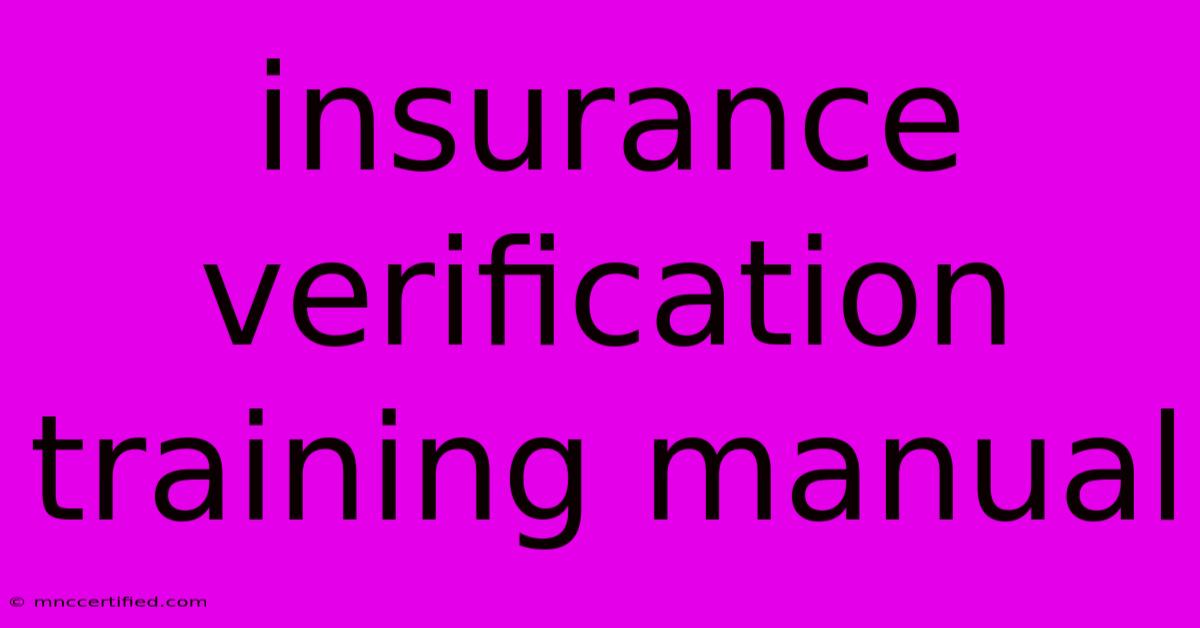Insurance Verification Training Manual

Table of Contents
Insurance Verification: A Comprehensive Training Manual for Success
Insurance verification is a crucial process in healthcare, ensuring accurate billing and smooth patient care. However, navigating the complexities of different insurance plans and procedures can be challenging. This comprehensive training manual will equip you with the knowledge and skills to master insurance verification, ensuring efficient workflows and financial stability for your practice.
Understanding the Importance of Insurance Verification
Why is insurance verification essential?
- Accurate Billing: Accurate insurance verification ensures that claims are submitted with correct patient information, coverage details, and billing codes, minimizing claim denials and rejections.
- Patient Satisfaction: Promptly verifying insurance benefits helps avoid unexpected out-of-pocket costs for patients, leading to increased satisfaction and positive patient experiences.
- Financial Stability: By effectively managing claim submissions and reimbursements, you can maintain a healthy cash flow for your practice, preventing financial strain.
- Compliance with Regulations: Thorough insurance verification ensures adherence to HIPAA regulations and other relevant healthcare guidelines, mitigating legal and ethical risks.
The Insurance Verification Process: A Step-by-Step Guide
Step 1: Patient Information Gathering
- Obtain Essential Details: Collect accurate patient demographic information, including name, address, date of birth, insurance card details, and any relevant medical history.
- Verify Patient Identity: Use reliable methods to confirm the patient's identity, such as a driver's license or government-issued ID.
Step 2: Insurance Plan Verification
- Identify the Primary Insurer: Determine the primary insurance provider for the patient, considering any secondary or supplemental plans.
- Confirm Coverage: Verify the patient's eligibility and coverage details, including effective dates, benefits, and co-payments.
- Check for Pre-Authorization Requirements: Determine if any procedures or treatments require pre-authorization from the insurance company.
Step 3: Pre-Authorization and Authorization
- Submit Pre-Authorization Requests: If required, submit pre-authorization requests for specific procedures or treatments, providing supporting documentation.
- Obtain Authorizations: Receive authorization approvals from the insurance company, ensuring necessary medical information is included.
Step 4: Billing and Claim Submission
- Prepare Accurate Billing Information: Utilize verified insurance details and approved authorizations to accurately populate billing forms.
- Submit Claims Electronically: Utilize electronic claim submission systems to ensure prompt processing and tracking of claims.
Common Insurance Verification Challenges and Solutions
1. Incorrect or Incomplete Information:
- Solution: Train staff on accurate data entry procedures and implement double-checking mechanisms.
2. Coverage Denials or Rejections:
- Solution: Conduct thorough pre-verification checks and maintain detailed documentation of all communication with insurance providers.
3. Pre-authorization Delays:
- Solution: Follow up regularly with insurance companies and use automated reminder systems to minimize processing delays.
4. Changing Insurance Policies:
- Solution: Stay informed about policy updates, use online resources, and communicate effectively with patients about potential changes.
5. Unfamiliar Insurance Plans:
- Solution: Utilize online databases and resources to research specific plans and stay up-to-date on new policies.
Best Practices for Effective Insurance Verification
- Dedicated Team: Designate a dedicated team or individual responsible for handling insurance verification tasks.
- Software Solutions: Implement dedicated software solutions to automate verification processes and streamline workflows.
- Regular Training: Provide ongoing training and refresher courses to enhance staff knowledge and skills.
- Clear Communication: Maintain transparent communication with patients and insurance companies throughout the process.
- Documentation: Keep meticulous records of all verification procedures, communication, and claim submissions.
Conclusion: Mastering Insurance Verification for Success
By embracing this comprehensive training manual and implementing best practices, you can effectively navigate the insurance verification process, ensuring efficient billing, patient satisfaction, and financial stability for your practice. Remember, ongoing learning and adaptation are crucial in the evolving healthcare landscape. Stay informed about insurance policy changes, technological advancements, and industry best practices to maintain excellence in insurance verification.

Thank you for visiting our website wich cover about Insurance Verification Training Manual. We hope the information provided has been useful to you. Feel free to contact us if you have any questions or need further assistance. See you next time and dont miss to bookmark.
Featured Posts
-
Independent Trading Co Plum Sweatshirt
Nov 09, 2024
-
Bronny James Expected To Play In G League On Saturday
Nov 09, 2024
-
Do I Need Vision Insurance After Lasik
Nov 09, 2024
-
How Much Is 28 Canadian In Us Dollars
Nov 09, 2024
-
Insurance Claim Check Mortgage Company
Nov 09, 2024